Chocolate Is the Ultimate Superfood
The many reasons why you shouldn't feel bad about your chocolate cravings
Back when I was in university, it was my exam-time ritual to take a block of chocolate with me to every exam. It was the number one food that eased my exam-taking anxiety and helped my brain function through the entire ordeal. Although I did not know much about nutrition back then (or, I thought I knew some things, most of which turned out to be wrong), I definitely did not think of chocolate as a superfood. Thankfully, that did not stop me from intuitively using it as a handy tool whenever faced with a stressful situation, and it was the one food that I always gravitated towards and “indulged on.”
Many people are made to feel ashamed for their “chocolate addiction.” Based on my understanding of the body, I view “addiction” not as an uncontrollable draw towards a potentially harmful substance/situation, but as the body trying to meet its needs and looking for substances that can fix an existing imbalance (even if that substance happens to be detrimental to long-term health.) For example, those that reach for alcohol and develop a dependency on it, tend to have a deficiency of the inhibitory and calming neurotransmitter GABA1, and alcohol is a GABA agonist (it increases GABA levels in the brain, lessening anxiety). While alcohol obviously has societal and health drawbacks, the draw towards it is rarely a sign of flawed character, and more often a sign of an imbalance in the body, which can come from nutritional deficiencies, poisoning, trauma, or living in a suboptimal environment.
Thankfully, unlike alcohol, chocolate does not have many negative “side effects.” I would actually argue that as long as it is sourced carefully, it has none! And the ways in which it can be beneficial to the body (which would explain why so many of us tend to crave it so much), are nearly endless.
Chocolate increases dopamine, which results in increased stress tolerance, improved memory, & overall better brain function
Since I started this article by talking about how chocolate has helped me in my exam-taking times, let’s unpack the science behind how it happened to do so.
Chocolate contains a compound called salsolinol, which has the ability to bind to dopamine receptors, especially the D(3) receptor.2 This means that chocolate has the ability to mimic dopamine in the body. Chocolate is also rich in the amino acids phenylalanine and tyrosine which are needed to synthesize dopamine. This means that chocolate not only contains compounds that boost dopaminergic activity in the brain, but it also gives you the building blocks to make your own dopamine, making chocolate a dopamine-boosting powerhouse. Chocolate (especially dark chocolate) also contains caffeine, which increases dopamine signalling in the brain,3 and has been shown to increase memory performance during exams, especially in the morning.4
Dopamine increases resilience to stress5 and helps us remain calm in high-pressure situations. Dopamine also improves memory retrieval, or in other words, it can help us recall information that we memorized.6 Dopamine helps us self-motivate and increases our perceptions of self-worth and ableness, and a drop in dopamine is behind the act of giving up (on a task or in general.)78 Dopamine is also involved in maintaining focus and attention, and low dopamine is seen in disorders such as ADHD.9
A state of low dopaminergic activity has been implicated in attention-deficit/hyperactivity disorder (ADHD). The clinical symptoms of ADHD include inattention, impulsivity and hyperactivity, as well as impaired learning; dopaminergic modulation of the functions in the hippocampus is important to both learning and memory.10
“We examined whether 1-year administration of a cocoa polyphenolic extract (Acticoa powder), orally delivered at the dose of 24 mg/kg per day between 15 and 27 months of age, affects the onset of age-related cognitive deficits, urinary free dopamine levels and lifespan in old Wistar-Unilever rats. Acticoa powder improved cognitive performances in light extinction and water maze paradigms, increased lifespan and preserved high urinary free dopamine levels. These results suggest that Acticoa powder may be beneficial in retarding age-related brain impairments, including cognitive deficits in normal ageing and perhaps neurodegenerative diseases.”11
*Acticoa powder is a cocoa powder with naturally preserved cocoa flavanols with a slightly bitter flavour and a light brown colour.12
Quick intermission! - “Dopamine” is not a dirty word
Here’s a quick intermission from chocolate to talk really quickly about dopamine and the knee-jerk reaction that many people experience when they hear the word “dopamine.”
The word “dopamine” leaves a bad flavour in some people’s mouths, partially due to the rise in popularity of content that advertises “dopamine fasting” or “dopamine detoxes,” usually in the context of breaking away from one’s social media, video game, or porn habits.
While all of these habits can be destructive, what’s rarely considered is that perhaps they are the body’s attempts at restoring equilibrium, and seeking “dopamine hits” is a way to prevent dopamine deficiency, which can be very detrimental to the brain. Dopamine deficiency in the brain is what causes Parkinson’s disease, and other disorders of brain degeneration, as dopamine is needed to transmit signals between neurons that coordinate language skills, movement, and memory formation.
The 1970s Rat Park13 experiments showed that rats only sought out morphine (which has a potent dopamine-increasing effect14) when they were locked in small, solitary cages. When the rats were placed in an engaging environment (massive cage, multiple rats housed together, lots of toys) they actively avoided the morphine, as their environment did not put them at risk of dopamine deficiency. Perhaps the reason we get “addicted” to social media or video games is that many of us live solitary, indoor lives without a tribe, without adequate fun, and without a higher purpose, and our “addictions” are subconscious attempts at preventing our brain from deteriorating due to dopamine deficiency.
Anyway - back to chocolate.
Chocolate reduces perceived stress and helps with anxiety by lowering cortisol
Salsolinol from chocolate is able to inhibit the release of ACTH,15 which is a pituitary hormone that stimulates the adrenal glands to release cortisol, the main hormone of stress. Chocolate’s cortisol-lowering ability is increased by its high sugar content as sugar directly lowers cortisol. One of cortisol’s roles is to maintain blood sugar in times of low energy availability or high energy demand (such as when running from or fighting a predator). When blood sugar is low (when we are underfed, especially underfed in carbohydrates), cortisol increases more, and eating some carbohydrates (sugar) can lower cortisol.
Cortisol increases both in times of danger and perceived danger. This perceived danger could be the fear of taking an exam or the worry of not being able to find the perfect gift in time for Christmas. In other words, in times of perceived danger, our life is not in danger, but the body perceives it as if it was.
Anyone who has experienced exam anxiety or anxiety due to a different “perceived danger” situation (having to perform on stage in front of an audience, doing a job interview), knows that our ability to think straight goes out the window when we get too stressed. Our palms are sweating, our heart rate accelerates, and our thoughts get blurry.
Research actually shows that high cortisol negatively affects cognitive function, worsening memory, language skills, and the speed at which we can process information.
“Clinical studies found that elevated cortisol was associated with poorer overall cognitive functioning, as well as with poorer episodic memory, executive functioning, language, spatial memory, processing speed, and social cognition.”16
Chocolate, by lowering cortisol, and increasing dopamine, can help shift our perception of the situation at hand to no longer perceive it as hopeless or outside of our control, and signal to the body that our life is not under threat. This helps us restore our cognitive function to deal with the situation in a level-headed, calmer manner.
To back up what's been written above, a study on 2nd year medical students17 was performed to measure the effects of chocolate on perceived stress. It used questionnaires to assess the students' levels of perceived stress before chocolate consumption and after two weeks of consuming 40 grams of chocolate daily. It found that their levels of perceived stress were significantly lower following the two weeks of chocolate consumption.
This explains why in stressful situations many of us reach for a chocolate bar. Often times it is an unconscious attempt at improving our ability to handle the stressful situation in a more balanced manner, without getting overwhelmed and totally freaking out.
Chocolate makes you lean
Departing from the cognitive effects of chocolate, let’s talk about its effects on other systems of the body.
Mainstream “health and fitness” outlets often demonize chocolate because of its calorie, fat and sugar content, insisting that chocolate consumption will lead to weight gain and obesity. This might be the case if weight gain was as simple as too many calories in and too few calories out, but the human body is a bit more complex than that.
Multiple studies have been done comparing chocolate consumption with the fatness of a population. They all found that chocolate consumption is negatively correlated with adiposity. In other words, people that consumed chocolate tend to be leaner.
“Higher chocolate consumption was associated with lower levels of total and central fatness, as estimated by BMI, body fat estimated from skinfolds and BIA, and waist circumference, regardless of potential confounders (P ≤ 0.01). (…) Our results demonstrate that a higher chocolate consumption was associated with lower total and central fatness in European adolescents."18
“Overall, 11.1% of the population self-reported any chocolate consumption in either of their 2 24-hour dietary recalls. Adjusted linear regression models showed that individuals who reported any chocolate consumption had 0.92 kg/m2 (95% confidence interval, 0.53-1.32) lower BMI, and 2.07 cm (95% confidence intervals, 1.22-2.92) lower waist circumference than those who reported no chocolate consumption. (…) In this representative sample of US adults, chocolate consumption was associated with lower markers of adiposity.”19
How can one explain these results? Well, different food compounds affect metabolism and body composition in different ways, and it just so happens that chocolate is high in multiple compounds that accelerate the metabolic rate and enhance the body’s ability to remain lean. This includes magnesium, copper, caffeine, and the fatty acid “stearic acid.”
Magnesium is needed to create ATP, which is the cellular energy that the body creates out of food. Copper, found in abundance in dark chocolate, is needed for the last step of the electron transport chain component of cellular respiration, which is the process through which ATP is made. If food can’t be converted into cellular energy, it’s stored as fat.
Caffeine is protective of the liver and has been shown to lower the risk of liver fibrosis20, improve liver enzymes21, and prevent the formation of fatty liver22. Since the liver is needed for the production of a good amount of the T3 (triiodothyronine) used to create ATP, for the neutralization of toxins that can inhibit energy production (including excess estrogens), and 500+ other functions, it makes sense that caffeine can contribute to having a healthy metabolism. Caffeine also directly increases the metabolic rate, partially by helping cells uptake glucose which can then be turned into cellular energy in the form of ATP & CO2.
However, in my opinion, when it comes to chocolate’s ability to help us stay lean, stearic acid is the real superstar.
Stearic acid - a miracle fat
Stearic acid is a long-chain saturated fatty acid found in foods such as tallow, coconut oil, and shea butter. However, the richest natural source of stearic acid is cocoa butter.
Stearic acid has been shown to be something along the lines of a “miracle molecule” when it comes to weight loss, with other notable health benefits, such as inhibiting tumour cells23, improving cardiovascular health24, and antagonizing estrogen25.
Many of these effects are due to stearic acid’s ability to cause mitochondrial fusion.26 Mitochondrial fusion is a process through which separate slightly damaged mitochondria merge into one. By merging into one, mitochondria can complement one another to make up for the other one’s defects and provide the functions that the other one lacks. Through doing so, these mitochondria generate all of the necessary components for optimal function.27 In short, through stimulating mitochondrial fusion, stearic acid can restore mitochondrial function, and mitochondria are where we produce the bulk of cellular energy.
“Dietary stearic acid leads to a reduction of abdominal fat and total body fat (TBF).
The percentage of TBF decreased 25%, while the percentage of total body lean mass (TBLM) increased 4% in the stearic acid diet group compared to the low fat mice when measured by DXA [DEXA scan].”28
More than just its effects on total body fat and lean mass, stearic acid has been shown to specifically reduce visceral fat in mice by up to 70%!29 Visceral fat is the “hidden fat” deep within the body, wrapped around organs, which can lead to the narrowing of blood vessels and is generally associated with poor health outcomes.
If you’re curious to see this phenomenon of stearic acid inducing rapid fat loss without caloric restriction applied to a human scenario, I’d recommend that you check out Brad Marshall’s article about his experiment with a stearic-acid-rich “croissant diet.”
Chocolate and longevity

There have been numerous articles in mainstream news over the years with doctors flabbergasted at the fact that many centenarians, such as Peggy Griffiths, Eunice Modlin, Thelema Cox, Frances Oldham or Jeanne Calment attribute their longevity to lifelong daily chocolate consumption. Peggy ate as much as 30 blocks of chocolate per week. Jeanne, who lived to be 122, ate 16 bars of chocolate per week.
Stearic acid (and the other saturated fats in cocoa butter) are likely what contributes to chocolate’s promotion of longevity. Cocoa butter contains approximately 60% saturated fat (palmitic, stearic, lauric, and myristic acids), 35% monounsaturated fat (oleic acid), and only 1% polyunsaturated fat (linoleic acid).
Stearic acid is a very saturated fat. It can outcompete PUFAs (polyunsaturated fatty acids) for assimilation into tissues. One study in mice showed that a diet high in stearic acid as the main dietary fat significantly delayed the occurrence of tumours in highly inbred mice, by interfering with the availability of PUFAs required for tumour production.30
Multiple studies have shown that the concentration of unsaturated fats in the tissues of various living beings is inversely correlated with longevity.
“Animals that naturally have a relatively low level of the highly unsaturated fats in their tissues have the greatest longevity. For example, the naked mole rate has a life expectancy of more than 28 years, about 9 times as long as other rodents of a similar size. Only about 2% to 6% of its phospholipids contain DHA, while about 27% to 57% of the phospholipids of mice contain DHA (Mitchell, et al., 2007).” - Ray Peat, PhD, “Fats, functions & malfunctions”
“Phospholipids containing highly polyunsaturated fatty acids are particularly prone to peroxidation and membrane composition may therefore influence longevity. Phospholipid molecules, in particular those containing docosahexaenoic acid (DHA), from the skeletal muscle, heart, liver and liver mitochondria were identified and quantified using mass-spectrometry shotgun lipidomics in two similar-sized rodents that show an approximately 9-fold difference in maximum lifespan. The naked mole rat is the longest-living rodent known with a maximum lifespan of >28 years. (…) DHA-containing phospholipids represent 27-57% of all phospholipids in mice but only 2-6% in naked mole-rats. (…) The lower level of DHA-containing phospholipids suggests a lower susceptibility to peroxidative damage in membranes of naked mole-rats compared to mice.”31
“Calorie restriction (CR) without malnutrition extends life span in several animal models. It has been proposed that a decrease in the amount of polyunsaturated fatty acids (PUFAs), and especially n-3 [Omega-3] fatty acids, in membrane phospholipids may contribute to life span extension with CR.* Phospholipid PUFAs are sensitive to dietary fatty acid composition, and thus, the purpose of this study was to determine the influence of dietary lipids on life span in CR mice. C57BL/6J mice were assigned to four groups (a 5% CR control group and three 40% CR groups) and fed diets with soybean oil (high in n-6 PUFAs), fish oil (high in n-3 PUFAs), or lard (high in saturated and monounsaturated fatty acids) as the primary lipid source. Life span was increased (p < .05) in all CR groups compared to the Control mice. Life span was also increased (p < .05) in the CR lard mice compared to animals consuming either the CR fish or soybean oil diets. These results indicate that dietary lipid composition can influence life span in mice on CR, and suggest that a diet containing a low proportion of PUFAs and high proportion of monounsaturated and saturated fats may maximize life span in animals maintained on CR.”32
* I agree with the hypothesis that it is not caloric restriction itself that extends lifespan, but the fact that eating less often means consuming fewer Omega-3 and 6 PUFAs.
“Short-living small mammal species have membrane lipids high in PUFA and are thus very prone to lipid peroxidation (Pamplona et al., 199833, 1999a34) and this is associated with elevated lipoxidative damage to proteins in small mammals (Pamplona et al., 200035). (…) Several investigators have used the 9-fold difference between the lifespans of pigeons and rats to investigate the mechanisms of aging. (…) The mitochondrial membranes of pigeon liver and heart are less unsaturated than rat liver and heart mitochondria (Pamplona et al., 199636, 1999b37) and the same difference has been demonstrated for the heart mitochondria of canaries and parakeets compared to mice (Pamplona et al., 1999c38).”39
It’s possible that the longevity of these chocolate-loving women was due in part to the highly saturated fatty acids from cocoa butter making their tissues more saturated and less prone to lipid peroxidation, and the consequent damage from the inflammatory end products of lipid peroxidation.
Chocolate and cardiovascular health
Due mostly to propaganda, many people still associate high saturated fat intake with heart disease, fueling concerns that the oh-so-demonized saturated fat in chocolate will “clog their arteries.” Interestingly enough, a high intake of saturated fat has actually been shown to increase survival in heart failure.40
A meta-analysis seeking to evaluate the existing literature on the effect of chocolate consumption on cardiovascular health looked at 14 studies including a total of 405,304 participants. It found that chocolate consumption was associated with a 16.3%, 13.5%, 17.1% and 16.2% reduction in the relative risk of total stroke, cerebral infarction, hemorrhagic stroke and myocardial infarction, respectively.41
These results are likely in part due to chocolate’s magnesium content, as well as its saturated fat content, protecting the heart against the toxic effects of PUFAs and PUFA breakdown products.
Not all chocolate is created equal
Now before you run to the store and buy all the chocolate that your heart desires, let’s talk about chocolate quality.
Lots of commercial chocolate brands (Milka, Cadbury, Nestle, etc.) use cheap ingredients and add soy or sunflower lecithin to their chocolates, increasing the chocolate’s PUFA content. I prefer to look for organic brands that do not use any form of lecithin in their production of chocolate.
Chocolate with higher cacao concentrations (dark chocolate) also poses a concern with regard to high levels of heavy metals. The cacao plant tends to accumulate cadmium from the soil and manufacturing processes can further contaminate it with lead. This is true for organic brands too. A report from December 15, 202242 published the analysis of heavy metal levels in different types of dark chocolate in the US. As per the analysis, the brands highest in lead, cadmium, and both lead and cadmium respectively are:
High in cadmium:
Beyond Good Organic Pure Dark Chocolate, 70% Cocoa
Beyond Good Organic Pure Dark Chocolate, 80% Cocoa
Equal Exchange Organic Extra Dark Chocolate, 80% Cacao
Lindt Excellence Dark Chocolate, 70% Cocoa
Scharffen Berger Extra Dark Chocolate, 82% Cacao
Alter Eco Organic Dark Chocolate Classic Blackout, 85% Cacao
Pascha Organic Very Dark Dark Chocolate, 85% Cacao
Dove Promises Deeper Dark Chocolate, 70% Cacao
High in lead:
Tony's Chocolonely Dark Chocolate, 70% Cocoa
Lily's Extra Dark Chocolate, 70% Cocoa
Godiva Signature Dark Chocolate, 72% Cacao
Chocolove Strong Dark Chocolate, 70% Cocoa
Lindt Excellence Dark Chocolate, 85% Cocoa
Endangered Species Bold + Silky Dark Chocolate, 72% Cocoa
Trader Joe's Dark Chocolate, 72% Cacao
Hu Organic Simple Dark Chocolate, 70% Cacao
Chocolove Extreme Dark Chocolate, 88% Cocoa
Hershey's Special Dark Mildly Sweet Chocolate
High in both cadmium and lead:
Theo Organic Pure Dark, 70% Cocoa
Trader Joe's The Dark Chocolate Lover's Chocolate, 85% Cacao
Theo Organic Extra Dark Pure Dark Chocolate, 85% Cocoa
Lily's Extremely Dark Chocolate, 85% Cocoa
Green & Black's Organic Dark Chocolate, 70% Cacao
As some good news, the following brands were found to be low in both lead and cadmium:
Mast Organic Dark Chocolate, 80% Cocoa
Taza Chocolate Organic Deliciously Dark Chocolate, 70% Cacao
Ghirardelli Intense Dark Chocolate, 86% Cacao
Ghirardelli Intense Dark Chocolate Twilight Delight, 72% Cacao
Valrhona Abinao Dark Chocolate, 85% Cacao
What to do if you’re concerned with metal toxicity
It’s great to have data and to be able to find out which brands are safer (at least for those that live in the US, where the above brands are available).
That being said, let’s remember that all cacao will contain some cadmium at least, due to the plant’s affinity for it, and that despite that, chocolate still shows to have incredible health benefits.
A high mineral intake in the diet can help to oppose the negative effects of metals. Calcium inhibits the absorption of lead and zinc inhibits cadmium. Having some chocolate or cacao powder with a glass of milk, opting out for milk chocolate, and having foods rich in zinc such as red meat and oysters as part of the diet can help to offset concerns regarding heavy metals.
For those seeking the benefits of stearic acid only, white chocolate is a great source of it, with a much smaller risk of heavy metal contamination as it does not contain any cacao powder. However, white chocolate will also be missing the benefits of cacao powder, such as high magnesium, copper, caffeine and flavonoid content.
I personally will continue my habit of daily chocolate consumption, while making sure that my diet is high in heavy-metal-protective minerals.
Content for entertainment purposes only. Not medical or health advice.
Krystal JH, Staley J, Mason G, Petrakis IL, Kaufman J, Harris RA, Gelernter J, Lappalainen J. Gamma-aminobutyric acid type A receptors and alcoholism: intoxication, dependence, vulnerability, and treatment. Arch Gen Psychiatry. 2006 Sep;63(9):957-68. doi: 10.1001/archpsyc.63.9.957. PMID: 16952998.
Melzig MF, Putscher I, Henklein P, Haber H. In vitro pharmacological activity of the tetrahydroisoquinoline salsolinol present in products from Theobroma cacao L. like cocoa and chocolate. J Ethnopharmacol. 2000 Nov;73(1-2):153-9. doi: 10.1016/s0378-8741(00)00291-9. PMID: 11025151.
Volkow ND, Wang GJ, Logan J, Alexoff D, Fowler JS, Thanos PK, Wong C, Casado V, Ferre S, Tomasi D. Caffeine increases striatal dopamine D2/D3 receptor availability in the human brain. Transl Psychiatry. 2015 Apr 14;5(4):e549. doi: 10.1038/tp.2015.46. PMID: 25871974; PMCID: PMC4462609.
Sherman SM, Buckley TP, Baena E, Ryan L. Caffeine Enhances Memory Performance in Young Adults during Their Non-optimal Time of Day. Front Psychol. 2016 Nov 14;7:1764. doi: 10.3389/fpsyg.2016.01764. PMID: 27895607; PMCID: PMC5107567.
Azadmarzabadi E, Haghighatfard A, Mohammadi A. Low resilience to stress is associated with candidate gene expression alterations in the dopaminergic signalling pathway. Psychogeriatrics. 2018 May;18(3):190-201. doi: 10.1111/psyg.12312. Epub 2018 Feb 8. PMID: 29423959.
Mareike Clos, Nico Bunzeck, Tobias Sommer “Dopamine Enhances Item Novelty Detection via Hippocampal and Associative Recall via Left Lateral Prefrontal Cortex Mechanisms,” Journal of Neuroscience 2 October 2019, 39 (40) 7920-7933; DOI: 10.1523/JNEUROSCI.0495-19.2019
https://www.sciencedaily.com/releases/2019/07/190725112547.htm
Parker KE, Pedersen CE, Gomez AM, Spangler SM, Walicki MC, Feng SY, Stewart SL, Otis JM, Al-Hasani R, McCall JG, Sakers K, Bhatti DL, Copits BA, Gereau RW, Jhou T, Kash TJ, Dougherty JD, Stuber GD, Bruchas MR. A Paranigral VTA Nociceptin Circuit that Constrains Motivation for Reward. Cell. 2019 Jul 25;178(3):653-671.e19. doi: 10.1016/j.cell.2019.06.034. PMID: 31348890; PMCID: PMC7001890.
Medin T, Rinholm JE, Owe SG, Sagvolden T, Gjedde A, Storm-Mathisen J, Bergersen LH. Low dopamine D5 receptor density in hippocampus in an animal model of attention-deficit/hyperactivity disorder (ADHD). Neuroscience. 2013 Jul 9;242:11-20. doi: 10.1016/j.neuroscience.2013.03.036. Epub 2013 Mar 27. PMID: 23541742.
Gjedde A, Storm-Mathisen J, Bergersen LH. Low dopamine D5 receptor density in hippocampus in an animal model of attention-deficit/hyperactivity disorder (ADHD). Neuroscience. 2013 Jul 9;242:11-20. doi: 10.1016/j.neuroscience.2013.03.036. Epub 2013 Mar 27. PMID: 23541742.
Bisson JF, Nejdi A, Rozan P, Hidalgo S, Lalonde R, Messaoudi M. Effects of long-term administration of a cocoa polyphenolic extract (Acticoa powder) on cognitive performances in aged rats. Br J Nutr. 2008 Jul;100(1):94-101. doi: 10.1017/S0007114507886375. Epub 2008 Jan 8. PMID: 18179729.
https://www.barry-callebaut.com/en/manufacturers/products/bensdorp-acticoa/100-F017906-AC
https://en.wikipedia.org/wiki/Rat_Park
Chen M, Zhao Y, Yang H, Luan W, Song J, Cui D, Dong Y, Lai B, Ma L, Zheng P. Morphine disinhibits glutamatergic input to VTA dopamine neurons and promotes dopamine neuron excitation. Elife. 2015 Jul 24;4:e09275. doi: 10.7554/eLife.09275. PMID: 26208338; PMCID: PMC4538365.
Melzig MF, Putscher I, Henklein P, Haber H. In vitro pharmacological activity of the tetrahydroisoquinoline salsolinol present in products from Theobroma cacao L. like cocoa and chocolate. J Ethnopharmacol. 2000 Nov;73(1-2):153-9. doi: 10.1016/s0378-8741(00)00291-9. PMID: 11025151.
Ouanes S, Popp J. High Cortisol and the Risk of Dementia and Alzheimer's Disease: A Review of the Literature. Front Aging Neurosci. 2019 Mar 1;11:43. doi: 10.3389/fnagi.2019.00043. PMID: 30881301; PMCID: PMC6405479.
Al Sunni A, Latif R. Effects of chocolate intake on Perceived Stress; a Controlled Clinical Study. Int J Health Sci (Qassim). 2014 Oct;8(4):393-401. PMID: 25780358; PMCID: PMC4350893.
Cuenca-García M, Ruiz JR, Ortega FB, Castillo MJ; HELENA study group. Association between chocolate consumption and fatness in European adolescents. Nutrition. 2014 Feb;30(2):236-9. doi: 10.1016/j.nut.2013.07.011. Epub 2013 Oct 17. PMID: 24139727.
Smith L, Grabovac I, Jackson SE, Veronese N, Shang C, López-Sánchez GF, Schuch FB, Koyanagi A, Jacob L, Soysal P, Yang L, Zhu X. Chocolate Consumption and Indicators of Adiposity in US Adults. Am J Med. 2020 Sep;133(9):1082-1087. doi: 10.1016/j.amjmed.2020.01.020. Epub 2020 Feb 15. PMID: 32067980.
Ebadi M, Ip S, Bhanji RA, Montano-Loza AJ. Effect of Coffee Consumption on Non-Alcoholic Fatty Liver Disease Incidence, Prevalence and Risk of Significant Liver Fibrosis: Systematic Review with Meta-Analysis of Observational Studies. Nutrients. 2021 Aug 30;13(9):3042. doi: 10.3390/nu13093042. PMID: 34578919; PMCID: PMC8471033.
Wadhawan M, Anand AC. Coffee and Liver Disease. J Clin Exp Hepatol. 2016 Mar;6(1):40-6. doi: 10.1016/j.jceh.2016.02.003. Epub 2016 Feb 27. PMID: 27194895; PMCID: PMC4862107.
Hayat U, Siddiqui AA, Okut H, Afroz S, Tasleem S, Haris A. The effect of coffee consumption on the non-alcoholic fatty liver disease and liver fibrosis: A meta-analysis of 11 epidemiological studies. Ann Hepatol. 2021 Jan-Feb;20:100254. doi: 10.1016/j.aohep.2020.08.071. Epub 2020 Sep 10. PMID: 32920163.
Habib NA, Wood CB, Apostolov K, Barker W, Hershman MJ, Aslam M, Heinemann D, Fermor B, Williamson RC, Jenkins WE, et al. Stearic acid and carcinogenesis. Br J Cancer. 1987 Oct;56(4):455-8. doi: 10.1038/bjc.1987.223. PMID: 3689663; PMCID: PMC2001814.
Kelly FD, Sinclair AJ, Mann NJ, Turner AH, Abedin L, Li D. A stearic acid-rich diet improves thrombogenic and atherogenic risk factor profiles in healthy males. Eur J Clin Nutr. 2001 Feb;55(2):88-96. doi: 10.1038/sj.ejcn.1601122. PMID: 11305631.
http://haidut.me/?p=1828 - “Stearic acid (SA) is an estrogen receptor antagonist,” - RE: https://refubium.fu-berlin.de/bitstream/handle/fub188/7395/Ban_Zsofia_diss.pdf?sequence=1&isAllowed=y
Senyilmaz-Tiebe, D., Pfaff, D.H., Virtue, S. et al. Dietary stearic acid regulates mitochondria in vivo in humans. Nat Commun 9, 3129 (2018). https://doi.org/10.1038/s41467-018-05614-6
https://www.nature.com/scitable/topicpage/mitochondrial-fusion-and-division-14264007/
Shen MC, Zhao X, Siegal GP, Desmond R, Hardy RW. Dietary stearic acid leads to a reduction of visceral adipose tissue in athymic nude mice. PLoS One. 2014 Sep 15;9(9):e104083. doi: 10.1371/journal.pone.0104083. PMID: 25222131; PMCID: PMC4164353.
Shen MC, Zhao X, Siegal GP, Desmond R, Hardy RW. Dietary stearic acid leads to a reduction of visceral adipose tissue in athymic nude mice. PLoS One. 2014 Sep 15;9(9):e104083. doi: 10.1371/journal.pone.0104083. PMID: 25222131; PMCID: PMC4164353.
Bennett AS. Effect of dietary stearic acid on the genesis of spontaneous mammary adenocarcinomas in strain A/ST mice. Int J Cancer. 1984 Oct 15;34(4):529-33. doi: 10.1002/ijc.2910340416. PMID: 6490204.
Mitchell TW, Buffenstein R, Hulbert AJ. Membrane phospholipid composition may contribute to exceptional longevity of the naked mole-rat (Heterocephalus glaber): a comparative study using shotgun lipidomics. Exp Gerontol. 2007 Nov;42(11):1053-62. doi: 10.1016/j.exger.2007.09.004. PMID: 18029129.
López-Domínguez JA, Ramsey JJ, Tran D, Imai DM, Koehne A, Laing ST, Griffey SM, Kim K, Taylor SL, Hagopian K, Villalba JM, López-Lluch G, Navas P, McDonald RB. The Influence of Dietary Fat Source on Life Span in Calorie Restricted Mice. J Gerontol A Biol Sci Med Sci. 2015 Oct;70(10):1181-8. doi: 10.1093/gerona/glu177. Epub 2014 Oct 13. PMID: 25313149; PMCID: PMC4612357.
Pamplona, R., Portero-Otin, M., Riba, D., Ruiz, C., Prat, J., Bellmunt, M.J., Barja, G., 1998. Mitochondrial membrane peroxidizability index is inversely related to maximum life span in mammals. J. Lipid Res. 39, 1989–1994.
Pamplona, R., Portero-Otin, M., Ruiz, C., Gredilla, R., Herrero, A., Barja, G., 1999a. Double bond content of phospholipids and lipid peroxidation negatively correlate with maximum longevity in the heart of mammals. Mech. Aging Dev. 112, 169–183.
Pamplona, R., Portero-Otin, M., Riba, D., Requena, J.R., Thorpe, S.R., Lopez-Torres, M., Barja, G., 2000. Low fatty acid unsaturation: a mechanism for lowered lipoperoxidative modification of tissue proteins in mammalian species with long life spans. J. Gerontol. 55A, B286–B291.
Pamplona, R., Prat, J., Cadenas, S., Rojas, C., Perez-Campo, R., Lopez-Torres, M., Barja, G., 1996. Low fatty acid unsaturation protects against lipid peroxidation in liver mitochondria from longlived species: the pigeon and the human case. Mech. Ageing Dev. 86, 53–66.
Pamplona, R., Portero-Otin, M., Requena, J.R., Thorpe, S.R., Herrero, A., Barja, G., 1999b. A low degree of fatty acid unsaturation leads to lower lipid peroxidation and lipoxidationderived protein modification in heart mitochondria of the longevouspigeon than in the short-lived rat. Mech. Ageing Dev. 106, 283–296.
Pamplona, R., Portero-Otin, M., Riba, D., Ledo, F., Gredilla, R., Herrero, A., Barja, G., 1999c. Heart fatty acid unsaturation and lipid peroxidation, and aging rate are lower in the canary and the parakeet than in the mouse. Ageing Clin. Exp. Res. 11, 44–49.
Hulbert AJ. On the importance of fatty acid composition of membranes for aging. J Theor Biol. 2005 May 21;234(2):277-88. doi: 10.1016/j.jtbi.2004.11.024. Epub 2005 Jan 24. PMID: 15757684.
Galvao TF, Brown BH, Hecker PA, O'Connell KA, O'Shea KM, Sabbah HN, Rastogi S, Daneault C, Des Rosiers C, Stanley WC. High intake of saturated fat, but not polyunsaturated fat, improves survival in heart failure despite persistent mitochondrial defects. Cardiovasc Res. 2012 Jan 1;93(1):24-32. doi: 10.1093/cvr/cvr258. Epub 2011 Sep 29. PMID: 21960686; PMCID: PMC3243037.
Ren Y, Liu Y, Sun XZ, Wang BY, Zhao Y, Liu DC, Zhang DD, Liu XJ, Zhang RY, Sun HH, Liu FY, Chen X, Cheng C, Liu LL, Zhou QG, Zhang M, Hu DS. Chocolate consumption and risk of cardiovascular diseases: a meta-analysis of prospective studies. Heart. 2019 Jan;105(1):49-55. doi: 10.1136/heartjnl-2018-313131. Epub 2018 Jul 30. PMID: 30061161.
https://www.consumerreports.org/health/food-safety/lead-and-cadmium-in-dark-chocolate-a8480295550/









No only is is difficult to find chocolate without lecithin, now in the USA a lot of bigger name companies are using PGPR as a replacement for cocoa butter. Disgusting. Just another example of corporate greed adulterating our food supply in the USA. Always read your labels!
Are there any brands of chocolate chips that are good?